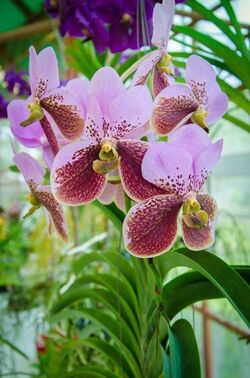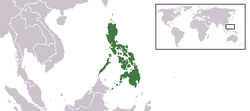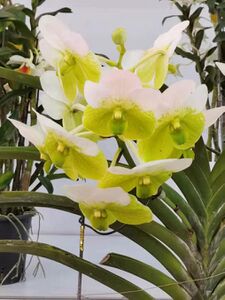Biology:Waling-waling
| Vanda sanderiana | |
|---|---|

| |
| flower detail | |
| Scientific classification Error creating thumbnail: Unable to save thumbnail to destination
| |
| Kingdom: | Plantae |
| Clade: | Tracheophytes |
| Clade: | Angiosperms |
| Clade: | Monocots |
| Order: | Asparagales |
| Family: | Orchidaceae |
| Subfamily: | Epidendroideae |
| Genus: | Vanda |
| Species: | V. sanderiana
|
| Binomial name | |
| Vanda sanderiana (Rchb.f.) Rchb.f.[1]
| |

| |
| distribution of Vanda sanderiana | |
| Synonyms[1] | |
| |
Vanda sanderiana is a species of orchid. It is commonly called Waling-waling[2] in the Philippines and is also called Sander's Vanda,[3] after Henry Frederick Conrad Sander, a noted orchidologist. The orchid is considered to be the "Queen of Philippine flowers" and is worshiped as a diwata by the indigenous Bagobo people.
Heinrich Gustav Reichenbach named it as Vanda sanderiana.
It has two forms, pink and white, also referred to as alba. M. Roebelin discovered the original pink variety in the Philippines in 1881 or 1882. Rudolf Schlechter separated Euanthe from Vanda in 1914 due to structural differences in the flowers.[4] For breeding purposes and registration by the Royal Horticultural Society, however, it is still treated as a Vanda.[5]
Vanda sanderiana is endemic to Mindanao in the provinces of Davao, Cotabato, and Zamboanga where it is found on the trunks of dipterocarp trees at elevations below 500 meters. Over-collected, the plant is considered rare in nature. It is often used in hybridization.[6]
Studies have shown that when raised at high altitude, the plant bears flowers early.
In 2004, a motion was filed in the House of Representatives of the Philippines to declare the Waling-waling as the country's national flower, replacing the Sampaguita.[7][8]
In 2013, a bill was passed by the Philippine Senate declaring the Waling-waling as a national flower alongside the Sampaguita.[9] However, the House Bill 5655 was vetoed by President Benigno Aquino III citing that other means were available to promote the protection and preservation of the orchid without declaring it a second national flower.[10]
Varieties
The Philippine Orchid Society, which incorporates an image of the flower in its logo, states that the species has three varieties:[11]
- Vanda sanderiana var. albata Reichb. f. in Gard. Chron. ser. 3.2 (1887) 9. Esmeralda sanderiana var. albata Will
- Described by Heinrich Gustav Reichenbach in The Gardeners' Chronicle in 1887, the plant's flower size is smaller than that of the species. Its lateral sepals are yellowish-green with white margins. Its dorsal sepal and petals are white with purple spots at the base. The labellum has purple dots. This plant was reported from Davao del Sur and South Cotabato on Mindanao Island where it grows as an epiphyte at elevations to 500 meters. This variety is now extremely rare in its natural habitat.
- Vanda sanderiana var. froebeliana Cogn. in Dict. Icon. des. Orch.Vanda t. 12 a (1903)
- This variety has bright rose flower stalks and has very large flowers compared to the species. The lateral sepals are bright yellow, with rose coloration towards the margins and densely covered with large purple reticulated veins. The dorsal sepal and petals are rose-colored on the upper half, while the lower half has brownish-purple spots.
- Vanda sanderiana var. labello-viridi Linden & Rodigas in Lindenia 1:85, t (1885) 40. Esmeralda sanderiana var. labello-viridi Will
- This variety is similar to the species, with the exception that the lip or labellum is green with crimson stripes.
See also
References
- ↑ 1.0 1.1 "Vanda sanderiana (Rchb.f.) Rchb.f." (in en). Royal Botanic Gardens, Kew. http://www.plantsoftheworldonline.org/taxon/661063-1. Retrieved 11 June 2022.
- ↑ "Vanda sanderiana(Waling-waling Orchid)". http://zipcodezoo.com/Plants/E/Euanthe__sanderiana/.
- ↑ "Vanda sanderiana [Rchb.f Schlechter 1914"]. The Internet Orchid Species Photo Encyclopedia. http://www.orchidspecies.com/euanthesanderiana.htm. Retrieved 2009-08-23.
- ↑ "Plant of the Week 01/07/2002 Euanthe Sanderiana alba Schlechter". http://www.killerplants.com/plant-of-the-week/20020107.asp.
- ↑ "Vanda Sanderiana at Fender's Flora Orchids". http://www.fendersflora.com/Vanda/sanderianagood.asp.
- ↑ "Vanda sanderiana (plant)". http://www.britannica.com/EBchecked/topic/622886/Vanda-sanderiana.
- ↑ "Legarda pushes for declaration of Waling-Waling as Nat'l Flower" (Press release). House of Representatives of the Philippines. January 31, 2013.
- ↑ Palacio, Rose (4 February 2013). "Senate passes bill declaring Waling-waling nat'l flower alongside Sampaguita". http://newsinfo.inquirer.net/352497/senate-passes-bill-declaring-waling-waling-national-flower.
- ↑ "Senate passes bill declaring Waling-waling nat'l flower alongside Sampaguita". 4 February 2013. http://newsinfo.inquirer.net/352497/senate-passes-bill-declaring-waling-waling-national-flower.
- ↑ "Veto Message of President Aquino on House Bill No. 5655". Philippine Government. 26 March 2013. https://www.officialgazette.gov.ph/2013/03/26/veto-message-of-president-aquino-on-house-bill-no-5655/. ""a second national flower has the pernicious effect of creating confusion in the minds of the public and the academe. Moreover, declaring the Waling Waling Orchid as the second national flower would have the effect of displacing the hallowed status of the Sampaguita, a cherished national icon, as the primary symbol of Philippine culture and artistry. Furthermore, there are other means to promote the protection and preservation of the Waling Waling Orchid without declaring it a second national flower.""
- ↑ "Waling-waling (Vanda Sanderiana)". http://www.orchid.ph/gallery.php?album_id=236.
External links
Wikidata ☰ Q15188539 entry
 |


